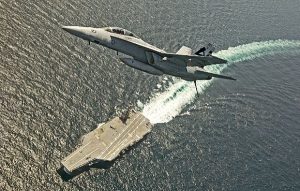 The newly-commissioned USS Ford (CVN 78) recovered and launched its first aircraft less than a week after commissioning. And while that achievement is all well and good, don’t get too carried away by the hype.
The newly-commissioned USS Ford (CVN 78) recovered and launched its first aircraft less than a week after commissioning. And while that achievement is all well and good, don’t get too carried away by the hype.
Wait for the Ford’s first deployment before really cheering this new carrier and all its new tech. As I told Project on Government Oversight’s Mark Thompson:
The post-commissioning air op hasn’t swayed skeptics. “The proof that this launch and recovery solution is THE solution won’t come in a showpiece set of one or two demonstration launches,” says Craig Hooper, a naval expert and senior analyst with Gryphon Scientific in Takoma Park, Md. “It’ll be when they show Ford can do this thousands of times while going few days without breaking either the launch or the recovery systems.”
The accelerated “first launch and recovery” operation grew from whispered press-corps concerns that USS Ford (CVN 78) was commissioned without launching a fixed-wing aircraft. Those concerns–while valid–were relatively trumped-up.
Though it has been usual practice to fly after delivery, those carrier critics do have a “fly before buy” point. Until now, first-in-class nuclear aircraft carriers worked through launch-and-recovery challenges before commissioning. The first-in-class USS Enterprise (CVN 65) was commissioned Nov 25, 1961, and launched its first aircraft on Oct 31, 26 days before commissioning. The first-in-class USS Nimitz (CVN 68) was commissioned on May 3, 1975, and launched and recovered its first aircraft on 12 April 1975, a good 22 days before commissioning.
But practices have changed over time. USS Carl Vinson (CVN 70), back in 1982, was the first nuclear aircraft carrier to carry out the initial aircraft launch and recovery ceremony post-commissioning, and the rest of the Nimitz Class generally launched their first aircraft two weeks to a little over a month after commissioning. The pace has generally picked up for the later Nimitz class carriers. The USS Ronald Reagan (CVN 76) was out launching and recovering aircraft twelve days after a July 12, 2003 commissioning (Its first aircraft was launched/recovered on July 24, 2003.)
The USS George H.W. Bush (CVN 77) was a different story. This “transition” to the Ford was commissioned January 10, 2009 but launched and recovered it’s first aircraft on 5/19/2009—a record 129 days after commissioning. Horrible performance, right?? Nope! We forget that the commissioning of CVN 77 was, in a kind gesture to the outgoing President and his family, completed before CVN 77’s 5/11/2009 delivery to the Navy. So while technically CVN 77 was launching and recovering a mere eight days after delivery, the “written” record unfairly shows a far less favorable progression towards completion.
USS Ford beat that eight-day record set by CVN 77. And that’s great–kudos to Huntington Ingalls for beating a record and marching in the right direction!
But that’s just not enough.
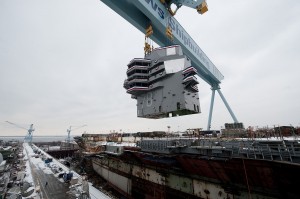 What Was Missing?
What Was Missing?
What was missing from the Navy’s announcement was any evidence that this flight was more than a “one off” thing–an exquisite small-batch launch/recovery iteration of a single type of aircraft.
That’s insufficient. The Navy’s not brewing Blue Bottle Coffee here. It’s operating an exquisitely expensive–and commissioned–aircraft carrier.
Let’s use the verbiage from the Navy press release to remind us why the Ford Class got such an exquisite flight deck in the first place:
The software-controlled AAG is a modular, integrated system that consists of energy absorbers, power conditioning equipment and digital controls, with architecture that provides built-in test and diagnostics, resulting in lower maintenance and manpower requirements. AAG is designed to provide higher reliability and safety margins, as well as to allow for the arrestment of a greater range of aircraft and reduce the fatigue impact load to the aircraft.
The mission and function of EMALS remains the same as the traditional steam catapult; however, it employs entirely different technologies. It delivers necessary higher-launch energy capacity, improvements in system maintenance, increased reliability and efficiency, and more accurate end-speed control and smooth acceleration. EMALS is designed to expand the operational capability of the Navy’s future carriers to include all current and future planned carrier aircraft – from lightweight unmanned aircraft to heavy strike fighters.
If we are just doing demonstration launches, then this aircraft carrier is not ready for prime time–the Navy needs to demonstrate the EMALS and AAG are driving towards their originally-stated goals every day, or the entire premise for the Ford Class goes away.
I’m not being a stickler here. The progression towards realization of the Ford’s originally articulated performance parameters is already glacial. Normally, when these carriers announce their first recovery/launch iteration, it comes with a “hey, we did XXXX number of traps in X days as we pressed forward with flight-deck certification.” As an example, here’s the CVN 77’s announcement after her first cruise:
The Navy’s newest aircraft carrier, along with the aircraft and personnel of Carrier Air Wing 1 and Air Test and Evaluation Squadron 23 safely completed 695 catapult launches and arrested landings while underway in the Atlantic Ocean May 18-29.
When will CVN 78 demonstrate similar performance?
Not for a good long while.
The other thing to wonder about is when are other aircraft going to be ready to work from the Ford? There are a only a handful of old stories about E-2Ds and CODs running through test cycles at Lakehurst, but the slow pace of fixing the EMALS problem with launching heavy Super Hornets and Growlers makes me a tad queasy. If EMALS software is as complex as, oh, AEGIS software, and can only be tweaked to accept new platforms and platform load-outs between PSAs (The Ford will be unable to launch fully-loaded Super Hornets without “exceeding acceptable load levels within the wings of the aircraft” until mid ’19 at the earliest?!? Really?!?), then the Ford Class does not have the launch/recovery interface we’re looking for. If we’re having trouble launching a loaded 48,000 pound Superhornet without strain, what’s EMALS doing to the Navy’s, ah, somewhat less robustly constructed 53,000 pound Hawkeyes?
American carriers need flexible launch solutions able to keep up with the blistering pace of change in aerospace–carriers need something robust enough to adjust and handle a wide range of different weights/configurations at a flip of a dial on a control panel someplace.
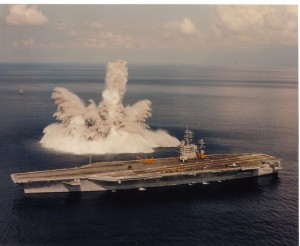 When Will Ford Be Ready?
When Will Ford Be Ready?
I suspect that the USS Ford will have the longest period between commissioning and first combat patrol of any nuclear carrier ever built.
The ground-breaking USS Enterprise was out operating in the Mediterranean and supporting the Cuban Quarantine a mere year after commissioning, and the first-in-class USS Nimitz was sent out on patrol little more than year after commissioning on 7 July 1976. That torrid pace to the front line has relaxed a bit over time; the USS Ronald Reagan departed on her first combat deployment on what is now a relatively standard two and a half years after commissioning (The Reagan left for the Gulf on 1/4/2006).
With all the tests to take and kinks to work out, the Ford was–of my last reading of the schedule–not set to deploy until about 2022, and, as part of the march towards battle readiness, the vessel was going to be put through a shock trial (which struck me as a good use of the ship while it works through various other problems). Today, we are seeing the likelihood of a shock trial decline, ostensibly to permit the vessel to deploy at a very politically tantalizing time—2019 or 2020. While I appreciate the Navy’s appreciation of political reality here, it’s the wrong thing to do if we want to speed up super-carrier production in a timely fashion.
However, if the Navy, in their increasingly desperate efforts to get the Ford to function, has waived or expects to waive a number of performance or survivability requirements as the ship works though some large system engineering challenges, then a shock trial may do more harm than good. If the Navy shocked the Ford under those circumstances, we’d essentially be shocking a one-off Franken-ship of a vessel that is imbued with an array of one-time weaknesses unique to this incredibly expensive $13+ billion dollar research platform.
So, if the Ford is so full of unique unknowns that a shock trial will fail to teach anything of interest, then maybe it is good to shock a later, more mature production variant THAT IS INCORPORATING FORD-DRIVEN FIXES (emphasis added), and then retrofitting shock trial-derived fixes on the Ford at a later date.
But with high-technology, I am a pessimist. I fully expect is that, in the name of expediency, the USS Ford shock trials will get canceled, only to see the schedule for a first combat deployment slide right back to the “originally scheduled” 2022 date as the Ford shambles from one surprise systems engineering oversight to another.
I also expect that, once the vessel’s fate becomes less a production problem than an opportunity for maintenance yards to make money, the costs will increase to the point where it threatens the schedule. The industrial base is great, but as Winston Churchill noted World War I, “once ships fall into dockyard hands, a hundred needs manifest themselves”. The shore establishment is a for-profit enterprise. Everybody in the business knows maintenance tasks enjoy a lot less nitnoid quality and cost-control-oriented scrutiny than newbuild projects. While that works well for most things, a savvy maintainer can lead their less-skilled (and oft-overwhelmed) naval counterparts into making bad decisions–and those bad decisions eat up the O&M budget, which, in turn, degrade the rest of the fleet.
To avoid another LPD-17 saga, where an over-budget, behind-schedule first-in-class ship spent years fumbling it’s way into the fleet (delivered in late 2005, the vessel expired in the midst of her first deployment, and wasn’t ready for prime time until at least 2011), the USS Ford will need years of consistent, high-level attention from Navy managers and Congressional overseers.
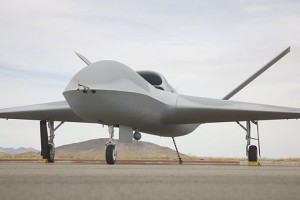 Wild Cards:
Wild Cards:
A few things worry me. First, as a risk-averse culture, the risk inherent in any new launch/recovery system is poorly understood. There is a higher likelihood of a major mishap–even a fatality–aboard the Ford as new, unanticipated problems with the new systems emerge and get worked through. It is only prudent that the air wing, the ship, the Navy, the Congress, the Media and the general public are sensitized to that risk. The days when fatal carrier mishaps were common are past, but the risk is real–particularly as the pressure to get the ship battle-ready increases. Everybody must be prepared to bounce back quickly from major setbacks–even fatalities. And the Navy will need to anticipate the potential for mishap-generated schedule-slip. Acknowledging–and, hell, celebrating–that risk is worth doing right now.
And second…even though launch and recovery systems are meant to be something of the ultimate in open systems architecture, who wants to bet that the builders of the EMALS/AAR system will tear another page from the Lockheed AEGIS playbook by making this complex system a tad bit less “open” or “agnostic” than is advertised? It would not surprise me if General Atomics makes the EMALS/AAR launch/recovery system almost proprietary, and (ahem) surprisingly well-prepared to accept the weight/launch characteristics of any General Atomics platform in the potential inventory. The reduced cost of shipboard integration alone could have huge implications for the impeding MQ-25A contest (Kudos to GA if they pull this off, I mean it’d be a legendary case for Business School students everywhere). But the Navy community needs to think very hard about how the complexity of major systems can drive the selection of supporting components to the company that made the original system. If significant “open systems” start driving defense monopolies, then the Navy needs to really mull their acquisition strategies over.
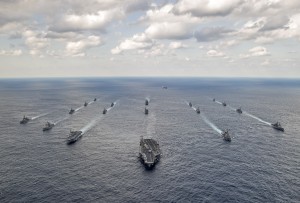 Conclusion:
Conclusion:
This is all about when we expect our next war at sea. If we have time to work EMALS, AAG, and the rest of the high-tech challenges out, then the Ford Class will be seen as an audacious leap forward. Now, we can debate about whether these challenges could have been worked out more efficiently and faster on, say, a smaller aircraft carrier, or a T-AKE-based UAV test-bed, but, for some reason, nobody wanted to bother with prototypes.
But then again, who needs prototypes?! the Navy has a history of undertaking full-scale experiments. I mean, the USS Nautilus was as successful as the USS Seawolf (SSN 575, NOT SSN 21) was not. We learned a lot from the USS Glenard P. Lipscomb (SSN 685). I suppose we will learn a lot from the USS Ford, too.
But for $13 Billion dollars of taxpayer money, we best hope the lessons we learn from the Ford Class will be useful. And hopefully we will learn them all in calm, peaceful seas–because the Ford won’t be ready for battle for some time to come.
